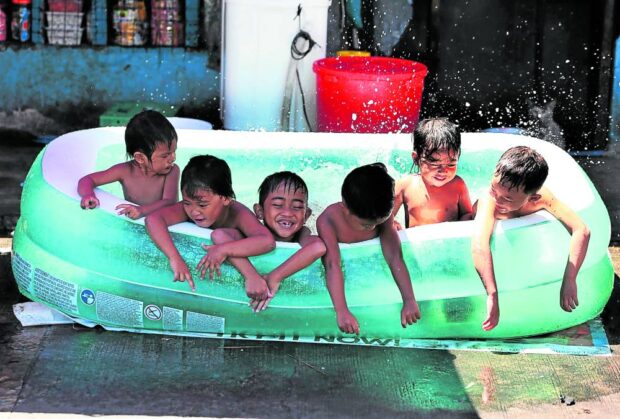Bare plan vs El Niño, Sen. Nancy Binay urges gov’t

NO BEACH, NO PROBLEM | Children enjoy a dip in an inflatable pool on Pasong Tirad in Makati City in this photo taken last week as the weather bureau declared the beginning of the dry season. Officials have also warned about the impact of El Niño on water supply as the heat index continues to rise in different parts of the country. (Photo by MARIANNE BERMUDEZ / Philippine Daily Inquirer)
MANILA, Philippines — With the El Niño phenomenon now under way, the government must lay down a “comprehensive” approach in addressing another possible water shortage in the country, Sen. Nancy Binay said on Monday.
Binay, in a statement, said Republic Act No. 6716 or the Rainwater Collector and Springs Development Act, enacted in 1989, laid down the government’s “accelerated water supply program.”
“We want to find out how many rainwater collection systems have been constructed in the 42,000 barangays in the country, how many are still working, who is in charge of their maintenance, how many are already defective and need to be rehabilitated,” she said.
“The government cannot allow itself to be repeatedly blindsided by [each] water shortage that is otherwise foreseeable,” she said. “We have been beset with the effects of El Niño for decades and every time the dry season comes, we are often caught by surprise by a water shortage.”
“It would be much appreciated if the NWRB (National Water Resources Board) can share its holistic and comprehensive water resource plan, their water allocation and reuse policy down to the [local governments] so that it can be implemented at the community level,” said Binay, who also urged consumers to do their part and be “practical” in conserving water.
“El Niño is here, and the food and water crises are real. We cannot afford to go back to a system of lining up for water rations,” the senator said.
‘Maximum heat’
The “hot” weather is expected to prevail in the next few months, the state weather bureau said on Monday.
Earlier, the Philippine Atmospheric, Geophysical and Astronomical Services Administration (Pagasa) anticipated El Niño to take full effect in the country by July, but it already noted an increase in humidity in Metro Manila and other parts of the country.
“It usually gets this hot in the country whenever it’s March, so it’s expected that temperatures go high. The maximum heat will be experienced by April and May,” said Pagasa weather specialist Dan Villemil.
This condition, he said, is caused by the dry season and the warm wind blowing from the Pacific Ocean.
As of last week, the highest heat index recorded by Pagasa was 47°C on Saturday, as felt in San Jose, Occidental Mindoro, and in Butuan City, Agusan del Norte.
The heat index is the temperature felt by people amid the combined air temperature and humidity.
Pagasa anticipates that indicator to continue its above-normal rise, from the 40°C to 42°C range in Dagupan City, Pangasinan, to 48°C in General Santos City.
Avoid heatstroke
Dagupan experienced its highest heat index of 54.9°C in April last year.
On Monday the heat index in the city peaked at 40°C, said Jose Estrada Jr., head of Pagasa’s Dagupan station.
He said that as a coastal city facing the Lingayen Gulf, Dagupan is enduring both the hot seashore surface temperature and humidity.
Dr. Joseph Roland Mejia, chief of Region 1 Medical Center in Dagupan, said his facility had yet to admit any patient suffering from heatstroke.
But he noted that many experienced hypertension. He discouraged residents from staying outdoors between 10 a.m. and 3 p.m. to avoid heatstroke.
‘Feels like hell’
In the island province of Bohol, the heat index on Sunday was recorded between 31°C and 42°C.
Joel Oguis, 47, a messenger, said he drank more than a gallon of water every day due to the intense heat so he could stay hydrated.
Many residents went to air-conditioned shopping malls and local beaches to find relief from the heat.
“The heat and humidity is really high… It feels like hell,” said Regor Cabalit, a resident of Tagbilaran City, noting that he would drink juice and crunch on ice cubes to cool off.
Pagasa weather specialist Vicente Malano urged the public to take precautionary measures.
“Let us drink a lot of water and avoid going out around afternoon where the sun is high and the heat is severe,” he said.